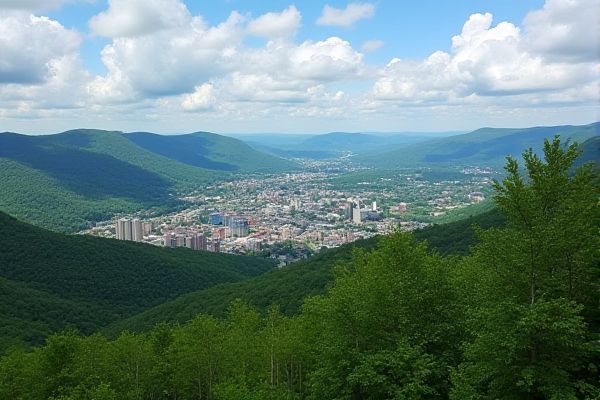
Insights from West Virginia residents and expatriate communities: Friendly and welcoming communities. Affordable cost of living. Scenic nature and outdoor activities. Strong sense of local pride. Thriving arts and culture scene. Varied weather with distinct seasons. Rich Appalachian history. Limited public transportation options. Focus on local produce and goods. Growing tech and industrial job markets.
Friendly and welcoming communities
Clarksburg, West Virginia, is renowned for its friendly residents, small-town charm, and strong community spirit, making it an ideal place for families and individuals to thrive. With a warm, tight-knit environment and a blend of historical charm and modern amenities, the city offers a welcoming atmosphere for all. For more information about the unique attributes and vibrant community of Clarksburg, visit the City of Clarksburg WV Blog to explore what makes this city a remarkable place to call home.
Affordable cost of living
West Virginia is highlighted as the most affordable state in the U.S., with a cost of living 25% lower than the national average, and housing costs that are 20-21% lower, making it an attractive option for both residents and those considering moving to the state. This affordability ranking, as detailed on the WBOY website, underscores the state's appeal and financial advantages.
Scenic nature and outdoor activities
West Virginia residents and visitors alike cherish the state's scenic nature and diverse outdoor activities, including hiking to the highest points, exploring hidden caverns, kayaking on peaceful lakes, and experiencing world-class adventures like rock climbing, whitewater rafting, and ziplining through the Appalachian Mountains. The region offers a wide range of activities, from mild to wild, ensuring something for every interest and skill level. For more detailed information about these exhilarating experiences, you can visit the West Virginia Tourism website.
Strong sense of local pride
West Virginia residents exhibit a strong sense of local pride, rooted in the state's unique history, geographic challenges, and the resilient communities that have developed despite the ebbs and flows of industrialization. Many of these communities maintain their independence and cultural identity. For further insights into these vibrant localities, you can explore their depth and diversity at WV Explorer, which delves into the heart of West Virginia's unique communities.
Thriving arts and culture scene
West Virginia's thriving arts and culture scene is evident in towns like Clarksburg, which features world-class performing arts venues, theatre companies, and museums, hosting notable performers and productions that engage the local and broader community. The state's arts scene is also highlighted in towns such as Berkeley Springs and Shepherdstown, where local galleries, public art, annual studio tours, and vibrant nightlife contribute to a rich cultural landscape that attracts both residents and visitors. To explore more about this vibrant scene, visit the Arts & Culture page which provides insights about the cultural experiences across the region.
Varied weather with distinct seasons
West Virginia experiences varied weather with four distinct seasons: Spring (March to May) offers mild temperatures and scenic outdoors, Summer (June to August) comes with humid and warm conditions, Fall (September to November) showcases colorful landscapes and dropping temperatures, and Winter (December to February) has temperatures often below freezing. For detailed information on planning your visit, you can check the best time to visit West Virginia on the Holidify website.
Rich Appalachian history
West Virginia's rich Appalachian history is marked by the presence of Native American hunters and settlers as far back as 14,000 years ago, with successive cultures such as the Adena and Fort Ancient people, followed by European settlement, the French and Indian War, and the eventual formation of the state during the American Civil War due to regional discontent and distinct cultural, social, and economic differences from eastern Virginia. For a deeper exploration, the history of West Virginia can be further examined through Encyclopaedia Britannica.
Limited public transportation options
West Virginia residents, particularly in rural areas, face limited public transportation options, with services like the Mountain Transit Authority providing essential but restricted routes, and only a fraction of rural residents having access to multiple transportation services such as airlines, rail, and buses.
Focus on local produce and goods
West Virginia residents and expatriate communities can support local produce and goods by visiting various farmers markets across the state, such as the Morgantown Farmers Market, Cheat Lake Farmers Market, and others, which offer fresh produce, handmade crafts, and local specialties year-round. To learn more about these vibrant community hubs, you can explore the diverse offerings at Visit Mountaineer Country, where you will find detailed information about each market and what makes them unique.
Growing tech and industrial job markets
West Virginia's tech sector boasts a robust employment landscape with over 31,000 workers, which constitutes 4.3% of the state's total workforce, generating a direct economic impact of $2.5 billion. The region is witnessing growth in emerging technologies and advanced manufacturing, propelled by initiatives aimed at attracting and supporting these industries. However, the adoption of advanced manufacturing techniques is still described as "immature" and "slow-growing." For more detailed insights, visit the CompTIA website, which explores the employment and economic impact of these sectors in West Virginia.
